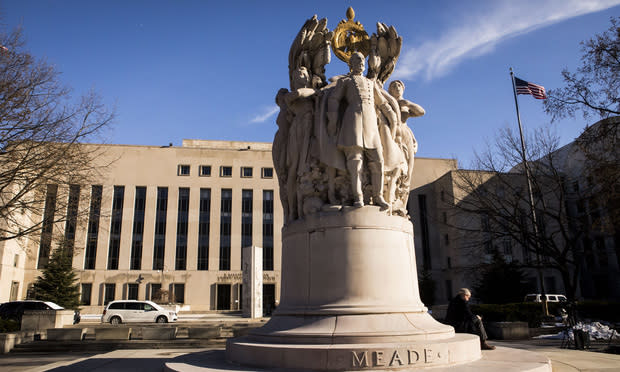Choose Carefully: Thinking Strategically About Venue When Mounting Agency Rule Challenges

E. Barrett Prettyman courthouse in Washington, D.C. March 22, 2018. Photo: Diego M. Radzinschi/ALM.
The D.C. Circuit is thought of as the epicenter of federal administrative law. Due in part to this reputation, it has become the default forum for petitioners challenging agency rules or adjudications. But the traditional view that the D.C. Circuit should be the forum of choice for petitioners challenging agency action is ripe for re-examination.
For some types of agency challenges, petitioners have no venue choice to make because the D.C. Circuit is the statutorily mandated forum. For example, the Clean Air Act explicitly provides that petitions for review challenging rules promulgated under certain provisions of that statute must be filed in the D.C. Circuit. But other agency statutes provide the petitioner with a choice of forums. The Toxic Substances Control Act, for instance, permits anyone adversely affected by an Environmental Protection Agency rule listing a particular substance as toxic to file a petition for review in either the D.C. Circuit or in the regional circuit in which they reside. The Occupational Safety and Health Act offers even more venue options for any person aggrieved by a final order issued under certain provisions of that statute; they may challenge that order either in the circuit in which the violation occurred, the employer’s home circuit, or in the D.C. Circuit. Similar choice-of-venue provisions exist in many other agency statutes.
These choice-of-venue provisions provide an opportunity for strategic litigation thinking that can be missed by petitioners that default to the D.C. Circuit as the traditional forum for administrative challenges. The other eleven regional circuits—each with their own body of administrative law—merit serious consideration as a superior forum for challenging a particular agency action. Since companies and advocacy groups with a wide geographic distribution often band together to mount a challenge to an agency rule, many of those regional circuits will be live options as the forum of choice for a given rule challenge. Instead of defaulting to the D.C. Circuit in such a situation, the better course is to carefully review all of the candidate circuits’ precedent both on deference to agencies generally and on any issues raised by the particular rule challenge. Only then can a petitioner make an informed decision about the best circuit in which to file.
A comparison of recent cases from the Fifth and Ninth Circuits illustrates the range of approaches the circuits take towards agency deference. In Oregon Restaurant and Lodging Association v. Perez, the Ninth Circuit addressed a Department of Labor rule that governed employers’ treatment of employee tip pools under the Fair Labor Standards Act. The Ninth Circuit first distinguished potentially dispositive circuit precedent that would have foreclosed extending deference under Chevron v. Natural Resources Defense Council and doomed the rule. After surmounting that initial hurdle, the Ninth Circuit embraced a robust view of Chevron deference, describing it as “a generous standard.” Concluding that the statute was silent on the specific issue addressed in the Department of Labor’s rule, the Ninth Circuit looked to legislative history and invoked Congressional intent to uphold the Department of Labor’s rule as a permissible interpretation.
The Fifth Circuit took a decidedly divergent approach to agency deference when it recently struck down a different Department of Labor rule—the Fiduciary Rule—in Chamber of Commerce of the United States of America v. Department of Labor. Among other changes, that regulation expanded the reach of ERISA’s fiduciary duties to encompass “virtually all financial and insurance professionals who do business with ERISA plans and IRA holders.” The Fifth Circuit applied the Chevron framework, but its analysis of the Fiduciary Rule was nevertheless quite rigorous. It first held that the Fiduciary Rule violated ERISA’s plain language. Then, taking a belt-and-suspenders approach to Chevron, the court went on to articulate seven distinct ways in which the Department of Labor’s interpretation of ERISA was unreasonable and arbitrary. Also of note is footnote 14 of the opinion, in which the Fifth Circuit pointed out that, although it is still bound by Chevron, the wisdom of applying that level of deference to agencies “has been questioned on substantial grounds.”
The narrow point is that Fifth Circuit’s recently expressed skepticism of overly deferential review of agency rulemaking marks it out as a court worthy of particularly close consideration as the forum for a challenge to agency action. But that serves to underscore the broader point that venue matters, and when the governing statute offers a choice of venues, savvy litigants should embrace that opportunity for strategic thinking at the very outset of a case. By engaging in this strategic thinking on the front end of an agency challenge rather than defaulting to the D.C. Circuit, a petitioner can place itself in the best position to succeed.
Mark Little is a senior associate and Travis L. Gray is an associate at Baker Botts. Their practices both focus on appellate litigation.


